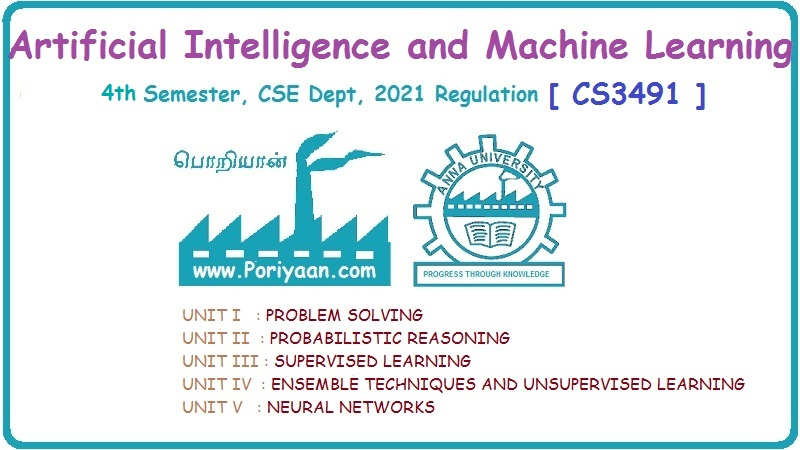Artificial Intelligence and Machine Learning: Unit I(c): Uninformed Search Strategies
Search Strategies
Uninformed Search Strategies - Artificial Intelligence and Machine Learning
At every stage in state space generating algorithms we need to apply searching procedure so as to reach to goal state. Search is a systematic examination at states to find path from the root state (initial state) to the goal state.
Search
Strategies
AU
Dec.-09, 13, 14, 16, May-10, 12, 13, 14, 15
At
every stage in state space generating algorithms we need to apply searching
procedure so as to reach to goal state. Search is a systematic examination at
states to find path from the root state (initial state) to the goal state. The
output of this procedure is the solution (goal) state.
Two Basic Search Strategies
1)
Uninformed search (Blind search): They have
no additional information about states other than provided in the problem
definition.
They
can only generate successors and distinguish between goal state and
non-goal state.
2)
Informed search (Heuristic search): This can
decide whether one non-goal state is more promising than another non-goal
state.
Key Point All the
search strategies are distinguished by the order in which the nodes are
expanded.
Uninformed Search Strategies
1.
B.F.S.
2.
D.F.S.
3.
Depth limited search
4.
Iterative deepening DFS
5.
Bidirectional search
6.
Uniform cost search
In
the following section we will discuss each uninformed searching in detail. For
each searching technique we will see its basic methodology, its algorithmic
implementation and its performance evaluation. Performance evaluation will be
done on the basis of 4 criterias we have seen previously namely,
1)
Completeness
2)
Optimality
3)
Time complexity
4)
Space complexity.
Generally
it does happen that space and time complexity depends on some factors hence we
will discuss them combinely.
1. Breadth-First Search
The
procedure: In BFS root node is expanded first,
then all the successor of root node are expanded and then their successor and
so on. That is the nodes are expanded level wise starting at root level.
The
implementation: BFS can be implemented using
first, in first out queue data structure where fringe will be stored and
processed. As soon as node is visited it is added to queue. All newly generated
nodes are added to the end of the queue, which means that shallow nodes are
expanded before deeper nodes.
The
performance evaluation
1)
Completeness: BFS is complete because if
the shallowest goal node is at some finite depth d, BFS will eventually find it
and will generate solution. (assuming that branching factor b is finite).
2)
Optimality: The shallowest goal node is
not necessarily optimal. BFS will yield optimal solution only when all actions
have the same cost, let it be at any depth.
3)
Time and space complexity: As the level of search
tree grows more time is incurred. In general if search tree is at level d then
O (bd+1) time is required, where b is the number of nodes generated
from each node, starting at root node i.e. root generates b nodes and each b
node generates b more and so on shown below.
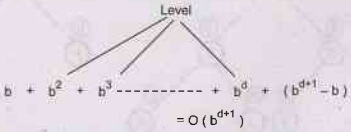
Every
node generated should remain in memory till its exploration. If branching
factor 'b' is more then more memory will be required.
For
example-
If
branching factor b = 10 at some level d = 6. If we assume 10,000 nodes will be
generated per second and per node 1000 bytes are required for storage.
Then
total generated nodes = 107 which will take 19 minutes but it will
take 10 Gigabytes for storing them.
We can conclude that for BFS space complexity is
major issue concerned than time complexity. Time complexity is critical issue
when depth of tree increases.
Key Point We can use
uninformed methods for exponential-complexity search only when problems have
smallest instances.
Algorithm
BFS (G, n)
//Breadth
first search of G
{
for
i := 1 to n do // Mark all vertices unvisited
visited
[i] = 0;
for
i = 1 to n do
if
(visited [i] = 0) then BFS (i);
}
BFS
• Time complexity - O(b d+1)
• Space complexity - O(b d+1)
BFS
D
and J are goal state.
[D
is found through the path] → (A-B-D) (shallowest goal)
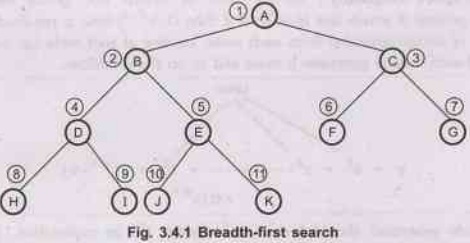
Note
The numeric value beside each node indicates the order in which
nodes are visited (reached).
2. Uniform Cost Search
The procedure: Uniform cost search
expands the node. 'n' with the lowest path cost. Uniform cost search does not
care about the number of steps a path has, instead it considers their total
cost. Therefore, their is a chance of getting stuck in an infinite loop if it
ever expands a node that has a zero-cost action leading back to the same state.
The
implementation: We can use queue data
structure for storing fringe as in BFS. The major difference will be while
adding the node to queue, we will give priority to the node with lowest
pathcost. (So the data structure will be a priority queue).
The
performance evaluation
1)
Completeness: Uniform cost search
guarantees completeness provided the cost of every step is greater than or
equal to some small positive constant "c".
2)
Optimality: If cost of every step is
greater than or equal to some small positive constant then uniform cost search
will yeild optimal solution, by reaching the goal state which has lowest path
cost.
3)
Time and space complexity: Uniform-cost search
does not care about the number of steps a path has, but only about their total
cost. Therefore, it will get stuck in an infinite loop if it ever expands a
node that has a zero-cost action leading back to the same state.
Uniform-cost search is guided by path costs rather than depths, so its complexity cannot easily be characterized in terms of b and d. Instead, let C* be the cost of the optimal solution, and assume that every action costs at least E. Then the algorithm's worst-case time and space complexity is O (b[C*/ϵ]), which can be much greater than bd.
Uniform
cost search
• Time complexity - O (bC/ϵ)
• Space complexity - O (bC/ϵ)
where
- C is the cost of optimal solution.
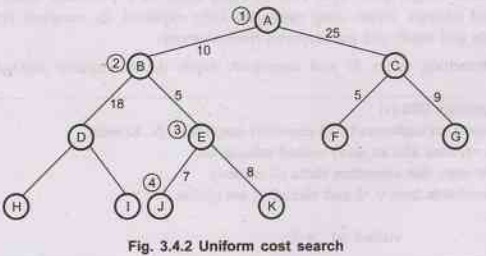
Assuming
J and D are both goal state.
A –
B – E – J
Note The costs are associated with each edge.
Note The numeric value beside each node indicates the order in which
nodes arevisited (reached).
3. Depth-First Search
The
procedure: Depth-first search always expands the
deepest node in the current unexplored node set (fringe) of the search tree.
The search goes in to depth until there is no more successor node. As these
nodes are expanded, they are dropped from the fringe, so then the search
"backs up" to the next shallowest node (previous level node) that
still has unexplored successors.
The
implementation: DFS can be implemented
with stack (LIFO) data structure which will explore the latest added node
first, suspending exploration of all previous nodes on the path. This can be
done using recursive procedure that calls itself on each of the children in
turn.
The performance evaluation
1) Completeness: As DFS explores all the nodes hence it guareentees the solution.
2)
Optimality: As DFS reach to deepest
node first, it may ignore some shallow node which can be goal state. Therefore
optimality is expected only when all states have same path cost.
3)
Time and space complexity: DFS requires some
moderate amount of memory as it needs to store single path from root to some
node to a particular level, along with unexpanded siblings. When same node gets
fully explored, its complete branch (its all descendants and itself) will get
removed from memory.
With
branching factor 'b' and maximum depth d, dfs requires storage of - bd+1 nodes.
Algorithm DFS (v)
//Given an undirected (OR directed) graph G = (V, E) with
//n vertices and an array visited initially set
// to zero, this algorithm visits all vertices
//reachable from v. G and visited [ ] are global.
{
visited [v] : = 1;
for each vertex w adjacent from v do
{
if (visited [w] = 0 then DFS (w);
}
}
• Time complexity – O (bd).
• Space complexity – O (bd +1).
4. DFS [Depth First Search]
Goal
state path - (A - B - D)
where
D is a goal state.
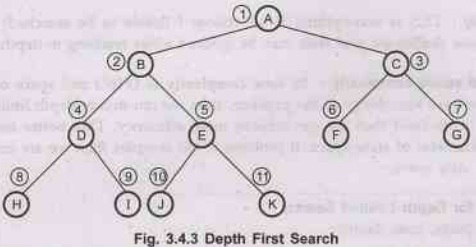
Note The numeric value beside each node indicates the order in which
nodes are visited (reached).
A
special case DFS → back tracking search: In this
only one successor is generated at a time rather than all the successors and
each partially expanded node remembers which successor to generate next.
This
search technique uses less memory than DFS as only 'd' nodes (maximum depth)
are required to store.
Drawback
of DFS: DFS can make a wrong choice and get
stuck going down a very long (even infinite) path when a different choice would
lead to a solution near the root of the search tree.
5. Depth-Limited Search (DLS)
The
procedure: If we can limit the depth of search
tree to a certain level then searching will be more efficient. This removes the
problem of unbounded trees. Such a kind of depth first search where in the depth
is limited at a certain level is called as depth limited search. It solves
infinite path problem.
The
implementation: Same as DFS but limited to
depth level 1. DLS will terminate with two kinds of failure. The standard
failure value indicates no solution and the cut-off value indicates no solution
within the depth limit.
The performance evaluation
1)
Completeness: DLS suffers from
completeness because if we choose 1 (levels to be searched) < d (actual
levels), when shallowest goal is beyond the depth limit 1. It generally happens
when 'd' is unknown.
2)
Optimality: DLS is non-optimal if we
choose I (levels to be searched) > d (actual levels) because shallowest goal
state may be ignored while reaching to depth level l.
3)
Time and space complexity: Its time complexity is
O (b') and space complexity is O (bl). If we have knowledge of the problem,
then we can decide depth limits. If we can find better depth limit then we can
achieve more efficiency. This better depth limit is termed as diameter of state
space. If problem is too complex then we are unable to find diameter of state
space.
Algorithm
for Depth Limited Search
DLS (node, goal, depth)
{
if(depth >=0)
{
if(node ==goal)
return node
for each child expand(node)
DLS (child, goal, depth-1)
}
}
General
steps for DLS
1.
Determine the node where the search should start and assign the maximum search
depth.
2.
Check if the current node is the goal state.
- IF
not: Do nothing
- IF
yes: Return
3.
Check if the current node is within the maximum search depth.
- IF
not: Do nothing
- IF
yes: a) Expand the vertex and save all of its successors in stack.
b) Call DLS recursively for all nodes of
the stack and go back to step 2.
DLS
[Depth-Limited Search]
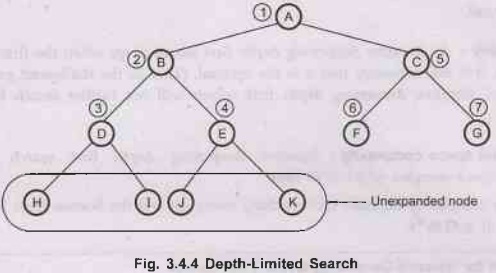
If
depth limit = 2 then nodes on level 2 are not expanded.
D
found (A-B-D)
(D,
E, F, G are generated but not expanded).
J though better goal than D could not reached because of algorithm technique.
Note
The numeric value beside each node indicates the order in which nodes are
visited (reached).
6. Iterative-Deepening Depth-First Search (IDDFS)
The
procedure: In iterative deepening depth-first
search, dfs is applied along with the best depth limit. In each step gradually
it increases the depth limit until the goal is found. It increases depth limit
from level 0, then level 1, then level 2 till the shallowest goal is found at
certain depth 'd'.
The
implementation: Iterative deepening depth
first search can be implemented similar to BFS (where queue is used for storing
fringe) because it explores a complete layer of new nodes at each iteration
before going on to the next layer.
If
we want to avoid memory requirements which are incurred in BFS then IDDFS can
be implemented like uniform-cost search.
The
key point is to use increasing path-cost limits instead of increasing depth
limits, is if we have such a implementations it is termed as iterative
lengthing search.
The
performance evaluation
1)
Completeness: It guarantees completeness
as the search does not stop until goal node is found.
2)
Optimality: As iterative deepening depth
first search stops when the first goal node is reached, it is not necessary
that it is the optimal. (That is, the shallowest goal reached is the final.
Iterative deepening depth first search will not further search for optimal solution).
3)
Time and space complexity: Iterative deepening
depth first search has very moderate space complex which is O (bd).
Its
time complexity depends on branching factor (b) and the bottom most level that
is depth (d). It is O (bd).
Algorithm
for Iterative-Deepening Depth First Search
//In IDDFS algorithm we are using DLS algorithm from earlier
section IDDFS (root, goal)
{
depth = 0
while (no solution)
{
solution = DLS(root, goal, depth)
depth depth+1
}
return solution
}
•
Example - IDDFS (Iterative Deepening Depth-First
Search]
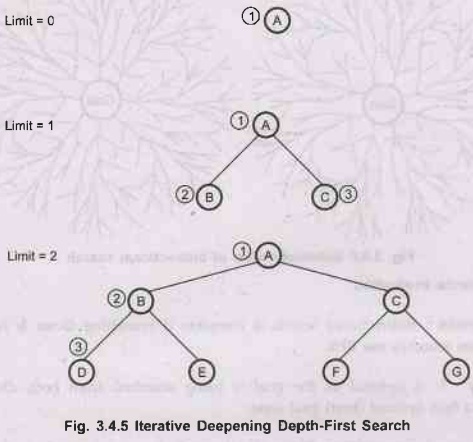
Note The numeric value beside each node indicates the order in which
nodes are visited (reached).
7. Bidirectional Search
The
procedure: As the name suggests bi-directional
that is two directional searches are made in this searching technique. One is
the forward search which starts from initial state and the other is the
backward search which starts from goal state. The two searches stop when both
the searches meet in the middle. [As shown in below diagram].
The
implementation: Bidirectional search is
implemented by having one or both of the searches check, each node before it is
expanded, is examined to see if it is in the fringe of the other search tree.
If so solution is found. Fringe can be maintained in queue data structure, like
BFS.
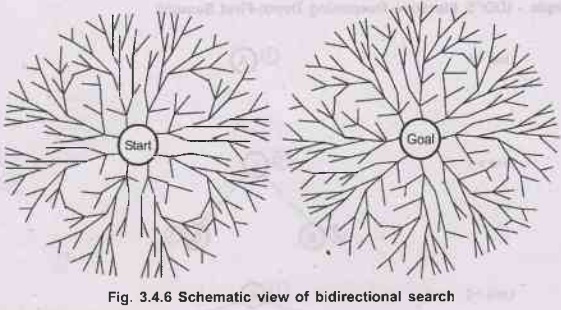
The
performance evaluation
1)
Completeness: Bidirectional search is
complete if branching factor b is finite and both directions searches use BFS.
2)
Optimality: It is optimal as the goal
is being searched from both directions. So guaranteed to find optimal (best)
goal state.
3)
Time and space complexity: Bidirectional search
has time complexity as O (b d/2), where 'b' is branching factor. It
is the important noticable point in case of backward a search because, we need
to get predecessors of the node. The easiest case is when all the actions in
the state space are reversible.
When
one goal state is there, the backward search is very much like the forward
search (like in 8 puzzle problem). If there are several explicitly listed goal
states (like in part picking robot) then it needs to construct a new dummy goal
state whose immediate predecessors are all then actual goal states. The worst
case in bidirectional search is when the goal test gives only implicit
description of some possibly large set of goal states.
For
example, in the game of chess 'checkmate' is the goal state which will have
many possible description.
The
memory requirement for bidirectional search is also moderate which is O (bd/2)
where b = Branching factor, d = Depth, where at least one of the search tree is
maintained in memory.
Bidirectional
search
Space
complexity - O (bd/2)
Time
complexity - O (bd/2)
Artificial Intelligence and Machine Learning: Unit I(c): Uninformed Search Strategies : Tag: : Uninformed Search Strategies - Artificial Intelligence and Machine Learning - Search Strategies
Related Topics
Related Subjects
Artificial Intelligence and Machine Learning
CS3491 4th Semester CSE/ECE Dept | 2021 Regulation | 4th Semester CSE/ECE Dept 2021 Regulation
